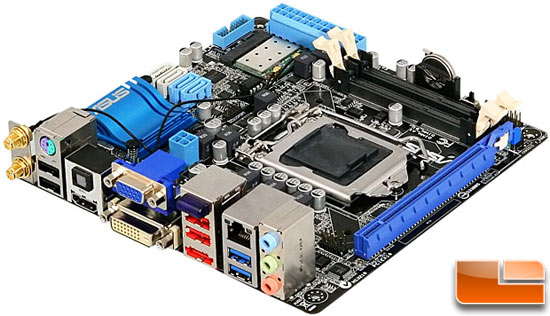ASUS P67 Motherboards – P8P67, Maximus IV Extreme & Sabertooth P67
Maximus IV Extreme & Sabertooth P67
Here we have a quick look at the very first ASUS motherboard that supports Intel Sandy Bridge CPUs that is part of the Republic of Gamers series, the Maximus IV Extreme. This motherboard is an ROG product and is aimed at enthusiasts and overclockers.

Just below the four DDR3 dual-channel memory slots you can see the board has on-board power and reset buttons. To the left of those you can see four switches that are on the board to enable/disable the four PCIe x16 slots on the M4E. Just below those you’ll find eight voltage check points along the edge of the motherboard. These are monitoring CPU, DRAM, PCH voltages among others. The board also has a switch called ‘LN2 Mode’ and this is for very extreme users who want to use liquid nitrogen cooling. This must also go along with the ‘DDR_Crazy’ LED light next to the memory. We can only assume that it allows for insane voltage options in the EFI BIOS to be unlocked. Speaking of the BIOS, the Maximus IV Extreme has not one, but two BIOS chips on the board and there is a switch on the board that allows you to change between the BIOS versions.

ASUS went with an NVIDIA NF200 chip on the board to boost the number of PCIe lanes up to 32. This means you can now run dual-GPUs are x16 on each slot or a set of three cards in Triple SLI at x16/x8/x8 for improved performance. This is clearly an enthusiast board and will have an expensive price tag on it when it comes out. The back panel is hard to see from the image ASUS sent us, but they told us that the board has the usual combination PS/2 mouse and keyboard port, a bunch of USB 2.0 and 3.0 ports, 8-channel audio, dual gigabit Ethernet, eSATA, optical audio and of course clear CMOS, reset and power buttons.

Next up we have the ASUS Sabertooth P67 that is part of the TUF Motherboard series by ASUS. This board has a ‘Tactical Vest’ on it that helps remove hot air from the board components. ASUS claims this board has undergone server grade testing and is extremely reliable. The board features nine smart real-time temperature reading across the system with instant fan speed adjustments to prevent overheating. It looks like air from the CPU cooler used to push air under this ‘vest’ to help keep the components cool. ASUS has included a place to mount an additional fan just under the CPU socket in case you need more airflow or if you use a water cooler.

The last board we have to show you is a mini-ITX H67 motherboardcalled the P8H67-I that should be popular for SFF and HTPC users. This little board has built-in wireless, Bluetooth and HDMI video out, which is critical for multimedia PCs. It also has a PCIe x16 slot for video cards, dual DDR3 notebook SO-DIMM memory slots, a pair of 6Gbps SATA III headers and SuperSpeed USB 3.0 and eSATA support on the rear I/O panel. This is a very interesting board and jam packed full of features for a board so small!
As you can see from these five motherboards the engineers at ASUS have been creating some amazing motherboards. We can’t wait to see the other eleven boards that they have designed! It looks like CES 2011 is going to be a very busy time if all the motherboard makers come out with boards like this!

Comments are closed.